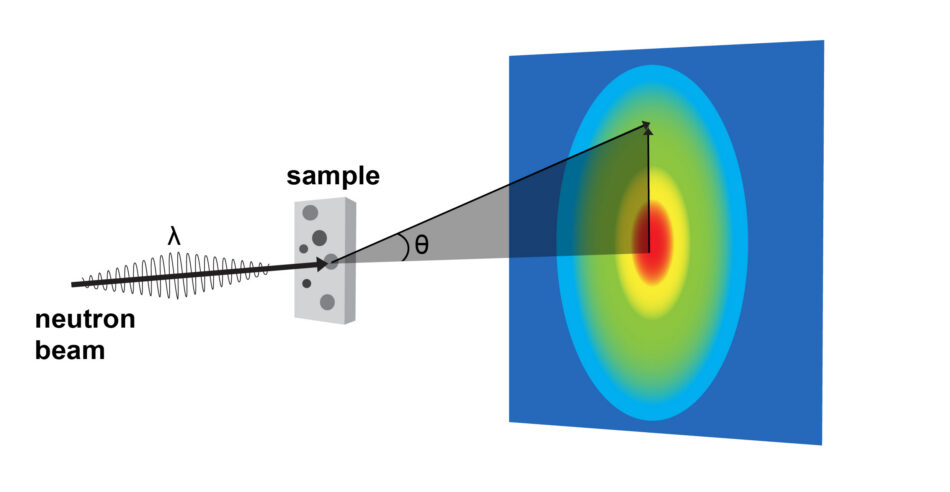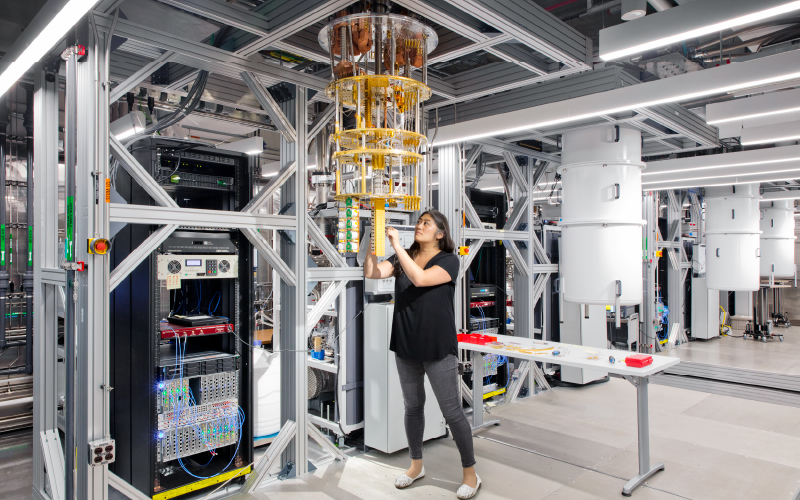
Neutrons for the quantum technologies of the future: investigating layered perovskites
How do scientists develop new materials for the computers of the future? Discover the rare magneto-electric properties of layered perovskites.

How tiny quantum particles dig into the mysteries of future materials.
The 2025 International Year of Quantum Science and Technology (IYQ) celebrates 100 years since the birth of quantum mechanics and recognises its relevance for the future of humankind. We are joining the celebrations with this brief account on neutron science – a quantum story from past to potential.
If we zoom in on the matter around us, such as the chair you are sitting on, the screen you are using to read this article and the jeans you are wearing, it turns out to be made up of tiny particles called atoms. If we keep zooming in, we will see that atoms consist of a nucleus surrounded by an electron cloud. The nucleus itself is made up of protons (positive charge) and neutrons (no charge). Here, we will focus on neutrons to peek into the quantum world.

Although neutrons are electrically neutral, they are far from boring. Their exciting story begins with their discovery by James Chadwick in 1932. As time went on, researchers realised that neutrons feature several characteristics that make them valuable probe particles for studying the world around us at the atomic level.[1]
Like all subatomic particles, neutrons are subject to the laws of quantum mechanics. This means, among other things, that their properties (particularly their energy) cannot take on any random value. Instead, they can only assume a set of well-defined, discrete values. In other words, neutrons exist in discrete quantum states.
On top of that, it turns out that the transitions between these states cannot be exactly predicted. Quantum mechanics can only tell us the probabilities associated with each possible state, i.e., reality is not fully deterministic but rather governed by probability laws.
While quantum mechanics always holds, it can be quite well hidden in everyday life, only revealing itself under certain circumstances. This is particularly evident when we study really small length scales.
One of the important concepts of quantum mechanics – developed at the beginning of the 20th century by many scientists, including Albert Einstein, Louis de Broglie, Max Planck, and Niels Bohr – is wave-particle duality: a neutron, like other subatomic particles, behaves simultaneously as a particle and a wave. Today, we can exploit this phenomenon to explore a large variety of fascinating phenomena using a technique called neutron scattering.

Alongside other tools for the characterisation of matter, such as X-rays and nuclear magnetic resonance, neutron scattering makes an invaluable contribution to our understanding of materials and processes occurring at different time and length scales.[2,3] In a neutron scattering experiment, a neutron beam with carefully tuned properties hits a sample. Neutron detectors positioned after the sample then measure the direction (and possibly other properties) of the scattered neutrons (for more information, read our previous article on neutron scattering for studying perovskites’ rare magnetoelectric properties.
Neutron scattering is inherently based on the wave-particle duality of neutrons. In fact, neutrons will be diffracted at the sample and interfere constructively or destructively, just as light waves or ripples on a lake surface do. The resulting pattern provides information on the sample they went through. Diffraction occurs when the wavelength matches the characteristic size of the structure that the wave is crossing. By selecting the energy of the incident neutrons (and thus their wavelength), we can explore different scales. These range from the macroscopic scale of the inner workings of batteries to the atomic scale of material structure.
Today, scientists all over the world are using neutrons to find answers to intriguing questions: How can we produce and store energy in an environmentally friendly way? How can we create materials for a more sustainable future? Is there a more efficient way to transmit and store digital information than the one we currently use?
The answer to some of these questions can be found in so-called quantum materials, which are materials that exhibit unusual magnetic properties due to quantum phenomena. Neutrons are uniquely well-suited to study quantum materials because of an intrinsic property that they share with other subatomic particles: their spin. The spin is a form of angular momentum and describes the properties of an object under rotation.
Thanks to their spin, neutrons have a magnetic moment. Simply put, they are essentially tiny magnets that interact with other magnetic materials. Indeed, we can use neutrons to examine the magnetic structure and dynamics of quantum materials in great detail, which offers huge potential for the information technologies of tomorrow.

An example of quantum materials is spin electronic (or spintronic) materials. Besides charge, we can also exploit the spin of electrons as an additional parameter. This opens up opportunities for more efficient data transfer and storage, which is of particular interest in the development of future computing technologies.
Some spintronic materials rely on ‘swirls’ of spins, also known as skyrmions. We observe the formation of skyrmions when a magnetic field is applied, even at room temperature. This has unique advantages. For example, it allows several bits of information to be sorted in a very small space, and information can be transported using magnetic waves without the need for electron movement (and the associated energy loss).
Another example of quantum materials are quantum spin liquids. They rely on quantum entanglement, a phenomenon in which the state of one particle depends on that of another particle, no matter how far apart the two “entangled” particles are (for more information, read our previous article on quantum computing). Quantum spin liquids are essentially entangled quantum states of nanomagnets, offering huge potential for the transfer and processing of information.
To use such materials in industrial applications, it is essential to understand and optimise their behaviour in fine detail. This is done through sophisticated neutron scattering experiments, in which scientists can select the spin state of the incoming neutrons – in other words, use a polarised neutron beam – and measure their spin state after interacting with the sample. In short, neutrons can provide a fairly complete picture of such quantum systems, paving the way for their use in industrial applications.

When James Chadwick discovered the neutron, did he envisage that entire research facilities would be built on his discovery, that neutron experiments would mesmerise researchers every single day across the globe, and that a community of scientists would form thanks to a tiny particle? We may never know. However, we can marvel at the discoveries that neutrons have helped us make, ranging from the advances in quantum physics to the development of novel medication and technology, and eagerly await what the neutron future holds.
[1] Sivia DS (2011) Elementary Scattering Theory: For X-ray and Neutron Users. Oxford University Press. ISBN: 9780199228676
[2] ILL annual report 2024: https://www.ill.eu/fileadmin/user_upload/ILL/1_About_ILL/Documentation/Annual_report/AR-24/AR2024.pdf)
[3] ILL general brochure, available in English, French and German (2024), https://www.ill.eu/about-the-ill/documentation/ill-brochures
Books:

How do scientists develop new materials for the computers of the future? Discover the rare magneto-electric properties of layered perovskites.

Stranger things: discover quantum computers, which are based on a new approach to computing powered by the strange behaviour of subatomic particles.

When you snap a selfie or film a video for social media, where does that information go? Find out how magnetic ‘storms’ could help us achieve better, faster data storage.